Using seaweed in the garden, no matter where you live, will have your garden thanking you. Seaweed, a product of Mother Nature’s aquatic garden, may be the best soil and plant amendment you can offer any garden.
This post may contain affiliate links at no additional cost to you. By making your purchases through the links on this website, IMSL may make a small percentage at no direct cost to you. IMSL only promotes products we use & truly believe in. Please refer to my Privacy & Disclosures for further information. IMSL thanks you for your support!
I am blessed. I live close to the shore. I can easily & sustainably harvest seaweed for use in my garden beds. In fact, it is one gardening chore that I look forward to. There may be no other gardening “chore” that I love most.
Strolling along at my leisure, listening to the sounds of both water & seagull, I gather what I know is undoubtedly the best soil, plant amendment and mulch I can offer my beds.
By taking advantage of this local, renewable, and did I mention FREE resource for those living close to shorelines, my gardening beds and plants have never been healthier. And for good reason.
Fortunately for those who do not have the benefit of living near the shoreline, organic seaweed and kelp products can be purchased and used.
BENEFITS OF USING SEAWEED IN THE GARDEN
The use of seaweed is not new. In fact it dates as far back as the Roman times according to John Henderson’s “The Roman Book Of Gardening”. We don’t have to go that far back, however, to acknowledge the benefits of using seaweed in our diets, our gardens, and yes, even our animals.
SEAWEEDS NUTRIENT CONTENT
Relatively low in nitrogen, seaweed boasts 60 elements, including trace minerals, micro-nutrients, and even plant growth hormones, cytokinins, all known to boost healthy plant growth.
Seaweed has no known shared diseases with land plants. In fact, it’s believed that the sea water feeding seaweed contains many fungal, bacteria, and viruses that seaweed actually creates a defense system. These defensive chemical compounds created by seaweed can in turn be utilized by our garden plants, thus assisting them in building their own defensive systems.
Containing carbohydrates (the energetic foundation of plants), seaweed helps build strong roots in our garden plants.
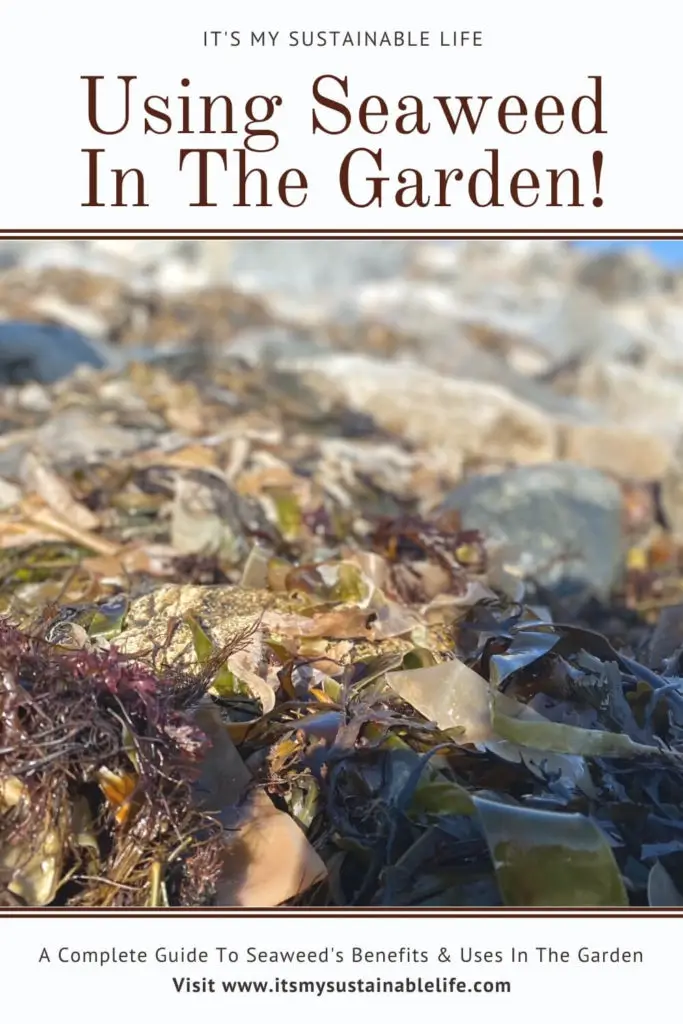
In a nutshell? Seaweed when used as a broad spectrum fertilizer, will aid in building the overall health of both your garden soil as well as the plants.
SEAWEED AIDS IN SOIL HEALTH
The use of seaweed in the garden aids in the soils composition & health. In addition to adding all the nutrients listed above, seaweed aids in improving the soils consistency when used as a mulch.
As the mulch begins to break down and incorporated into compacted soil, the soil will, over time, become aerated, lighter, & more moist as water retention is increased.
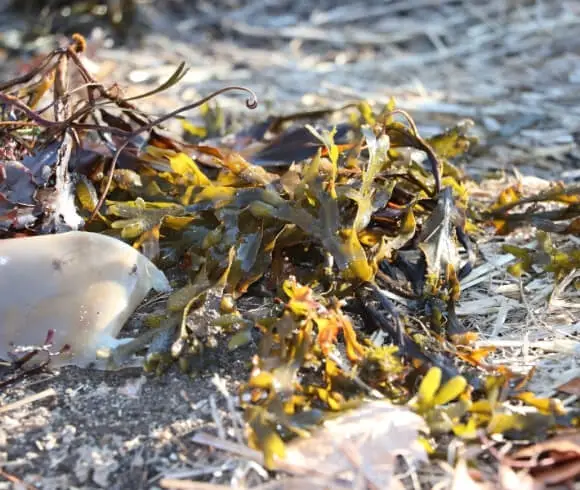
This spring/early summer I will be harvesting once again and begin to utilize seaweed as mulch in the garden, hopefully adding a good 4-6 inch depth.
ADDED BENEFITS OF USING SEAWEED IN THE GARDEN
What? There’s more? Yup! What’s the biggest issue that “bugs” the heck out of me in the garden? You got it! Pests 🙂
While many mulches become hiding places for common garden pests such as slugs, earwigs, and others, seaweed doesn’t. When seaweed is used as a mulch in the garden, it’s natural salt content repels slugs & other pests (they don’t like it) and the seaweed begins to dry, crumble, and become sharp. Great for the aerating the soil, but most pests don’t appreciate “sharp” edges. Especially slugs as these sharp edges can cut into their soft bodies.
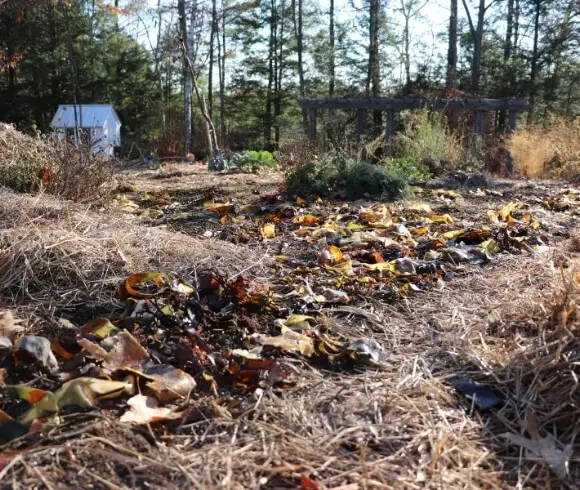
Mulch is used in my garden to supress & reduce weeds and help retain moisture. The problem? Many mulch options, straw, hay, and even bark mulch can cause further weeds to sprout. When used as a mulch, seaweed is by far our choice for a healthy, weedless garden. Why? Seaweed contains no seed heads, which translates into less weeds. Can you say heck ya?
CAN YOU PUT SEAWEED DIRECTLY ON THE GARDEN
Yes, yes, and yes! The beauty of being able to utilize sustainably harvested seaweed directly from the shore is that there is very little you need to do prior to adding it to your beds.
Whether you rinse the surface salt or not largely depends on when you add the seaweed to your garden & where you are located. More on this below.
HOW TO GATHER SEAWEED FOR USE IN THE GARDEN
As local rules and regulations may vary, you may want to contact the town and/or state in regard to any harvesting policies they may have.
As with most wild-crafting and foraging practices, be conservative when foraging. I don’t recommend going into a good size pile and taking it all. These beds or piles harbor marine life, and offer shelter & food for them. Don’t begin to pull seaweed off rocks willy-nilly either. Be selective, take a bit and leave the most. We can all share in it’s goodness 😉
Most anyone who utilizes seaweed for their gardening purposes recommend choosing seaweed that’s located mid-beach (the area between the tide and the high-tide line) as it’s a bit dryer and easier to gather. In our rocky coastline, this often means along the highest edge of the tide-line, but still among the rocks.
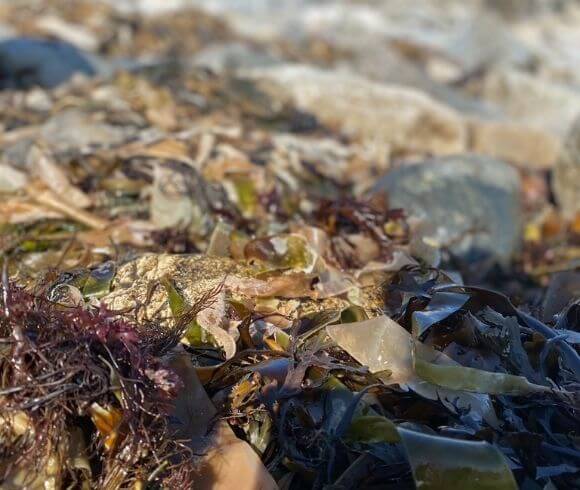
Keep in mind, seaweed is typically wet. That translates to heavy. So if you are harvesting without some additional muscle for assistance in carrying it, you may want to consider what you will be carrying it in. As I typically have some “muscle” (you know who you are 😉 ) along for the ride, I have no issue filling up a large gardening bucket.
If I go alone, you can betcha I will be using either an onion sack, a woven poly bag or even a smaller sized bucket. Something that will drain & be easy to carry (your hands do get slimy).
HOW TO USE SEAWEED IN THE GARDEN
So you’ve gathered your seaweed. Now what? There are only a couple considerations to think about prior to using your harvested kelp.
Many are concerned that the salt found in seaweed would be detrimental to the garden. My feeling is if you live in an environment that receives plenty of rainfall or are mulching late fall as you complete your fall garden chores, don’t worry. Any excess salt will be dissolved without issue.
However, if you are mulching around the plantings, I take the added precaution of rinsing the seaweed several times either in a large bucket or by laying out and spraying with a hose.
Apply the gathered seaweed as soon as possible into the garden. Seaweed breaks down quickly and you will end up with a slimy mess if left too long, making it near impossible to spread easily as mulch.
When using seaweed as a mulch around the garden plantings, apply in a thick, 4-6″ layer. As stated, it breaks down quickly and this thick layer will allow for full coverage of the soil you are hoping to cover. Within a couple of days, you will see that it has shrunk & dried up considerably, most likely leaving some soil exposed. Ideally, in a weeks time, another added layer of 4-6″ will give the needed coverage to retain moisture & supress weeds for a good couple of months time.
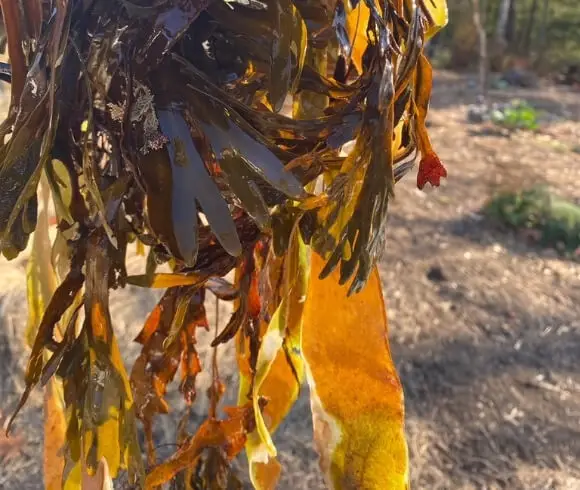
Use a different mulch for garden paths. Although the seaweed is beneficial for the garden, the high traffic areas will suffer from being walked on continuously, eventually allowing weeds to sprout as the seaweed continues to breakdown. A thick layer of straw, hay, or if you are fortunate enough to find the gold standard in my opinion in salt marsh hay is better suited to use in the pathways or high traffic areas of the garden.
Allow your plants to breathe by leaving a bit of space around the base of the plant as you do with any mulching system.
OTHER USES FOR SEAWEED IN THE GARDEN
Are there other ways to utilize the benefits of seaweed in the garden? Absolutely! A few that I am planning on incorporating this upcoming growing season are as follows.
COMPOSTING SEAWEED
To add the nutrient rich seaweed to your compost, do just that. Add to your compost, layering as you would any green & brown organic matter. Rinsing or cleaning your seaweed is not necessary, but again, if you are concerned, you are welcome to rinse several times.
By adding seaweed to the compost you are adding the trace minerals and beneficial components to it as well. A word of caution when adding seaweed to the compost pile. Be sure to add plenty of brown matter (leaves, straw, hay) allowing spaces to be created in the pile, thus, allowing for air-flow. If an anaerobic (without oxygen) state is created by lack of brown matter, you will smell it. And smell it good, just sayin’ 😉
CREATING SEAWEED “TEA”
Everyone knows a “cup of tea makes everything better”. Foliage, plant roots, and garden soil will all benefit from a good dose of tea too, seaweed tea that is.
To make a seaweed tea simply add seaweed to a container with a lid and cover with fresh water. Loosely place the cover on the container and leave for a minimum of three weeks and up to a year. Strain off your composted seaweed tea, dilute with water, and use as a foliage, root, and soil amendment.
NOTE: This “brew” will smell! Find a place to compost this that is out of the way or at the very least, down wind 🙂 You can thank me later.
CREATE A DRIED SEAWEED AMENDMENT
To make a dried seaweed soil amendment, simply do just that. Dry the seaweed by laying strips and pieces out in the sun until dry & brittle. Crumble into small pieces and use to amend new beds, in the planting holes of tomatoes, potatoes, and other plants, or simply spread around the root of the plant and gently turn in.
The uses of seaweed in the garden are endless, it’s benefits are boundless. Whether you are using freshly harvested seaweed you have foraged yourself, or a dried kelp or seaweed product you have purchased, your garden will truly thank you in it’s production & overall health.
Be sure to share your thoughts on using seaweed in the garden in the comments below! I love to hear about your experiences.
How do you use seaweed in your garden?
Love, Light, & Laughter ~

OTHER GARDEN ARTICLES YOU MAY BE INTERESTED IN
Growing Microgreens Hydroponics Vs Soil
When Life Hand’s You Heirloom Seeds Just Plant ‘Em

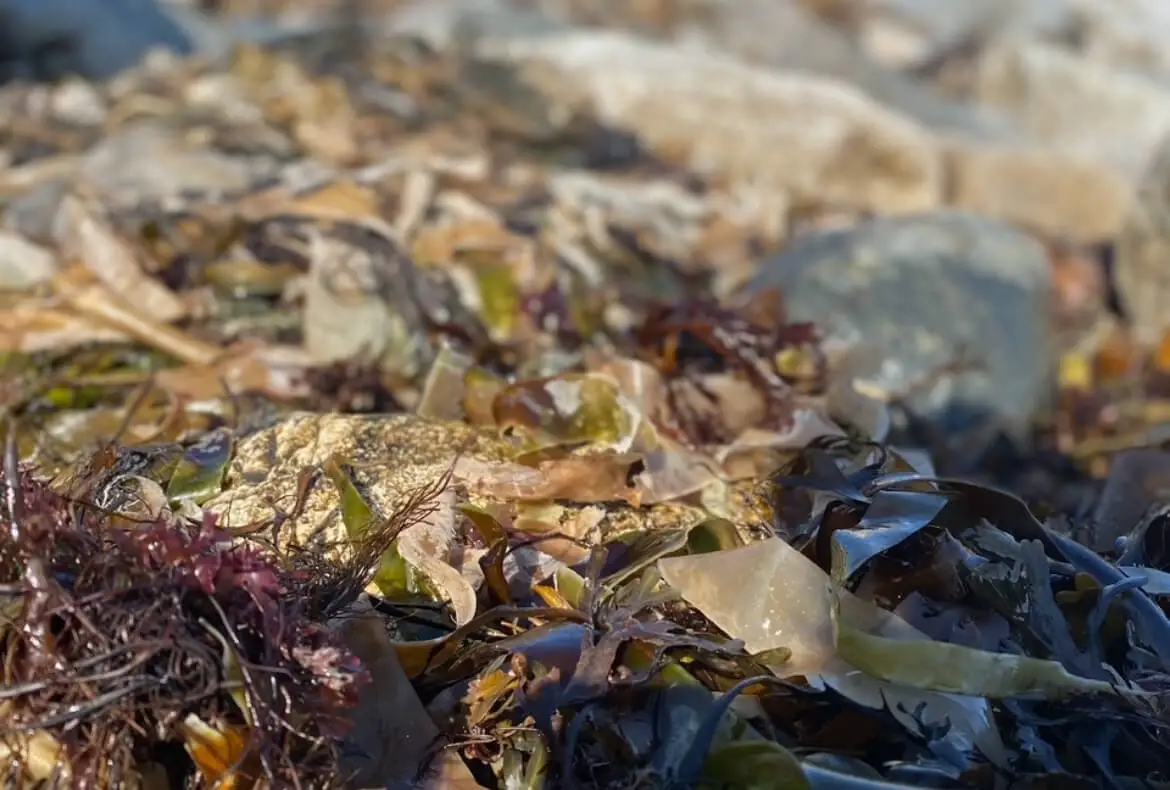

29 comments
My family complained so much about the smell of the tea and I found so many bugs in it that I found a solution. I use a large beer brewing bucket with a one way bubbler. That allows the air to escape but creates no smell and can be completely sealed so nothing tries to hatch in it. By how much do you dilute your finished product? I’ve read everything from 15 parts water to 5 parts water. I eventually put the whole container of solution in a huge garbage can and filled it up with water. I have no clue if I’m doing it “right” as I’m pretty new to sustainable gardening. Your thoughts?
Great tip! I think the dilution amount to use really depends on what it is you are fertilizing. For general garden use, I would recommend 4 to 5 tablespoons per gallon of water. For house plants, about 1 tablespoon per gallon. I have not ever had the experience of “over” use, so use this as a rough guide.
Hope this helps a bit, and I thank you for reading!
I use dried seaweed for myself. I haven’t used it yet in my garden. Sadly, I am very landlocked with no access to fresh seaweed. It would be fun to forage for it.
I never heard of this – how cool! We live relatively close to the beach, so we will definitely use seaweed next season. Thanks!
These add such a cool texture to the garden!
I’ve never heard of this before! Thanks for sharing! Great info!
seaweed, who knew? I really want to see a photo of you enjoying the shore in your wellies then dragging tons of wet seaweed home – sounds like a good giggle.
Hahaha..it is a site I can assure you!
Can I bring seaweed home to Michigan from my travels? Besides smelly, and mildew/molty from travel would it still work? Asking for a friend… 🙂
Sure, why not? LOL! Let me be the first to hear of your travels please….
This is a great tip! We are landlocked here in Oklahoma, so it won’t be as easy to come by. My daughter is wanting to start a little garden next season, so we’ll have to remember this.
I had no idea that seaweed can be used as mulch and fertilizer. I am absolutely among the people who would have thought that the salt would be detrimental to the garden. This makes me wish I live near the shore!
Fortunately, there are fertilizers available for purchase for gardeners such as yourself! Hope you can take advantage of them!
Fascinating! I don’t live close to an ocean, so seaweed would not be on my radar. Learned something new today, lol!
Wow, I would never have thought of Seaweed. I wish I lived near a coast to walk along and gather it up!
Right? You can still utilize seaweeds nurient benefits, however. It will take purchasing sadly. Thanks for reading!
Good information for when I am able to start gardening again.
I never would of thought you could use seaweed in your garden, how cool. We’re experimenting with our first compost bin this next spring.
Oh fun! If you can be sure to add it to the compost pile!
WOW this is amazing! I can’t wait to try this in my garden! I had never heard of this before and living in the desert my soil could use the nutrients!
That’s a hot tip! I know that seaweed is so good to eat too!
This is so good to know. My goal is to up my garden game next year so I will have to look into seaweed!
I had NO idea that seaweed could be used in a garden. And all of the benefits are amazing!!
This is an interesting idea! Thanks for sharing!
This is so clever! I know that eating seaweed is super healthy but never thought about how great it would be for plants! Wish I lived near a beach like you, haha.
I wish you did as well! You can purchase the fertilizer for your beds if you wish so not all is lost 🙂
I had no idea how beneficial seaweed is to a garden (probably because I live Texas, far away from the ocean lol).
You know I am not a gardener, however I would think this is just nutrient packed stuff that would make your garden burst with growth. What a great way to use an abundant resource. I always come away wanting to garden, Thanks!
I lived in a beach town most of my life and never thought to use seaweed in the garden! This is so interesting! Thanks for sharing. -Marie from This Dear Casa